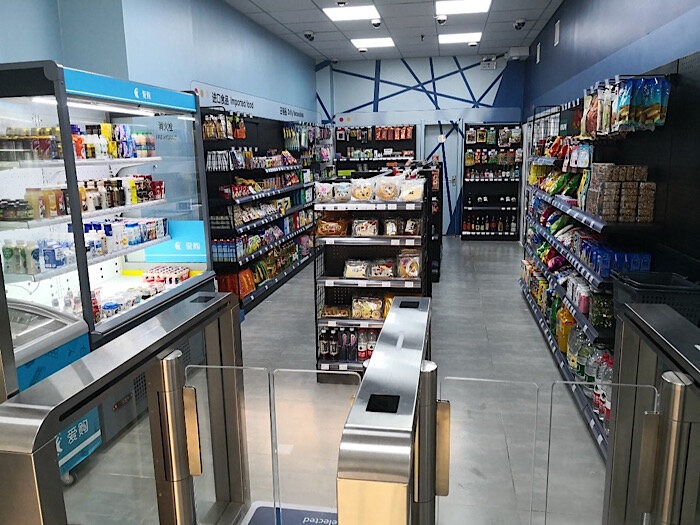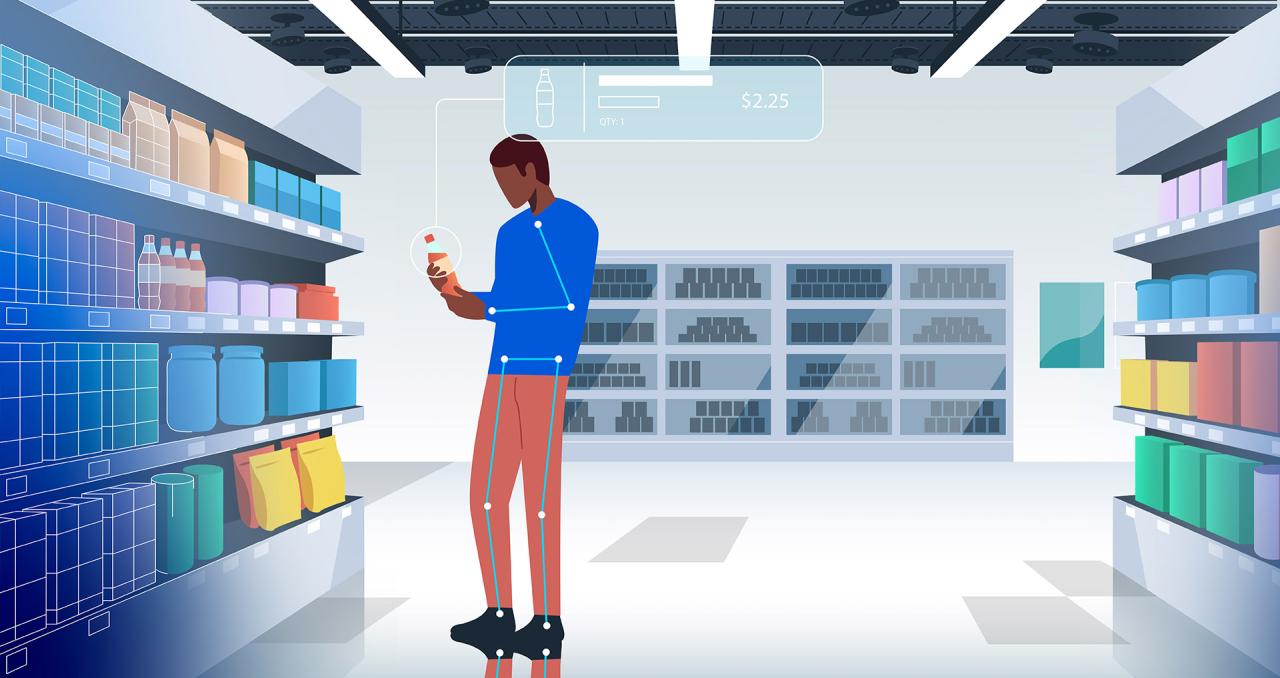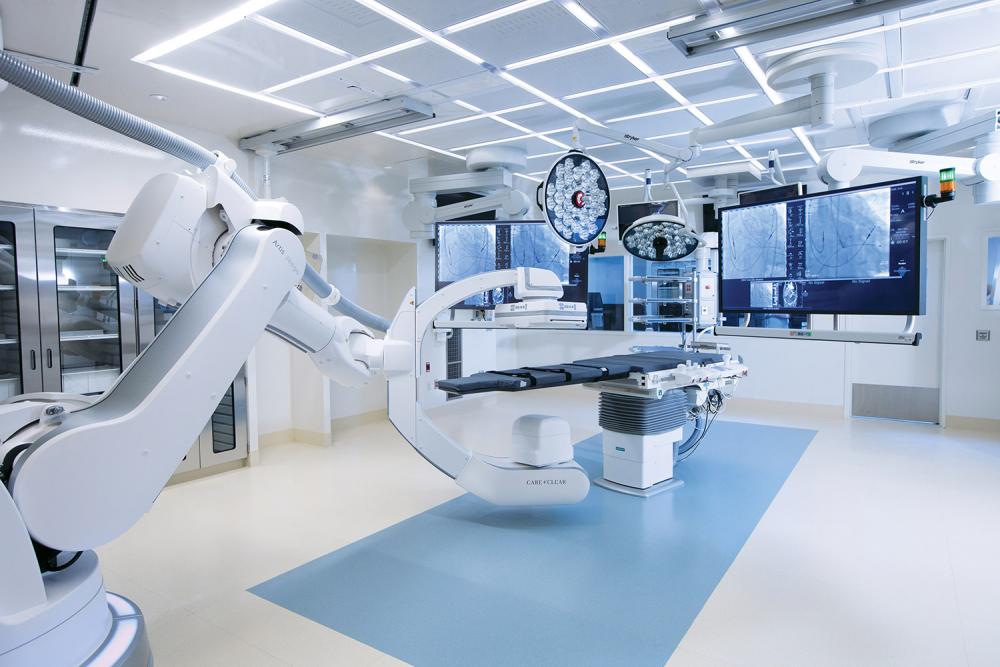Grocery Store Technology Innovations: Shaping the Future of Shopping
Grocery store technology innovations are revolutionizing the way we shop, transforming a mundane task into a seamless and personalized experience. From self-checkout kiosks to AI-powered inventory management, these advancements are […]

Grocery store technology innovations are revolutionizing the way we shop, transforming a mundane task into a seamless and personalized experience. From self-checkout kiosks to AI-powered inventory management, these advancements are enhancing efficiency, convenience, and customer satisfaction.
These innovations are not just about speed and efficiency; they are about creating a more engaging and personalized shopping environment. Imagine walking into a grocery store where shelves recommend products based on your preferences, digital displays showcase nutritional information, and robots help stock shelves and deliver groceries. This vision of the future is closer than you think.
Self-Checkout and Automated Payment Systems
Self-checkout systems have revolutionized the shopping experience, offering both customers and store owners a faster and more convenient way to complete transactions. These systems utilize technology to automate the checkout process, allowing customers to scan their items, pay, and receive their receipts without interacting with a cashier.
Advantages and Disadvantages of Self-Checkout
Self-checkout systems offer numerous benefits for both customers and store owners.
Customer Advantages
- Increased Convenience: Self-checkout systems allow customers to shop at their own pace, eliminating the need to wait in line. This is particularly beneficial during peak shopping hours or when customers have limited time.
- Enhanced Privacy: Customers may feel more comfortable using self-checkout systems, as they do not have to share their personal information with a cashier.
- Greater Control: Self-checkout systems give customers greater control over their shopping experience, allowing them to scan their items and pay at their own speed.
Customer Disadvantages
- Difficulty with Bulky or Fragile Items: Some customers may find it challenging to scan bulky or fragile items, as they may require assistance from a cashier.
- Technical Issues: Self-checkout systems can sometimes experience technical issues, which can lead to delays or frustration for customers.
- Limited Assistance: Customers may not have access to the same level of assistance at self-checkout kiosks as they would with a cashier.
Store Owner Advantages
- Reduced Labor Costs: Self-checkout systems can significantly reduce the need for cashiers, leading to lower labor costs for store owners.
- Increased Efficiency: Self-checkout systems can speed up the checkout process, reducing wait times for customers and allowing store staff to focus on other tasks.
- Enhanced Customer Satisfaction: By offering a convenient and efficient checkout experience, self-checkout systems can contribute to increased customer satisfaction.
Store Owner Disadvantages
- Initial Investment Costs: Implementing self-checkout systems can require a significant initial investment in hardware and software.
- Maintenance Costs: Self-checkout systems require regular maintenance and updates, which can add to ongoing costs for store owners.
- Security Concerns: Self-checkout systems can be vulnerable to theft or fraud, requiring store owners to implement appropriate security measures.
Innovative Self-Checkout Technologies
Self-checkout technology is constantly evolving, with new innovations emerging to enhance the customer experience and improve efficiency.
Biometric Authentication
Biometric authentication systems use unique biological characteristics, such as fingerprints or facial recognition, to verify a customer’s identity. This eliminates the need for customers to enter PINs or use physical cards, streamlining the checkout process and enhancing security.
Smart Carts
Smart carts are equipped with built-in scanners and payment terminals, allowing customers to scan their items as they shop and pay for their purchases directly from the cart. This eliminates the need to visit a self-checkout kiosk, further enhancing convenience and speed.
Mobile Payment Integration
Mobile payment integration allows customers to pay for their purchases using their smartphones or other mobile devices. This eliminates the need for physical cash or cards, simplifying the checkout process and providing greater flexibility for customers.
Designing an Intuitive and Efficient User Interface
A well-designed user interface is crucial for a successful self-checkout system. It should be intuitive, easy to navigate, and provide clear instructions to guide customers through the checkout process.
Key Design Considerations
- Simple and Clear Instructions: The user interface should provide clear and concise instructions, using simple language and visual cues to guide customers through each step.
- Intuitive Navigation: The layout and design should be intuitive, allowing customers to easily find the information they need and complete their transactions without confusion.
- Visual Feedback: The user interface should provide visual feedback to confirm actions and guide customers through the process. For example, a progress bar can indicate the stage of the checkout process.
- Error Handling: The system should handle errors gracefully, providing clear and helpful messages to guide customers in resolving issues.
Enhancing Customer Satisfaction and Streamlining the Checkout Process
Self-checkout systems can significantly enhance customer satisfaction and streamline the checkout process by offering a convenient, efficient, and personalized experience.
Key Benefits
- Reduced Wait Times: Self-checkout systems can significantly reduce wait times, allowing customers to complete their purchases more quickly.
- Increased Control: Customers have greater control over their shopping experience, allowing them to scan their items and pay at their own pace.
- Personalized Experiences: Self-checkout systems can be customized to offer personalized experiences, such as displaying promotions or loyalty program information.
Inventory Management and Supply Chain Optimization: Grocery Store Technology Innovations
Grocery stores are constantly striving to improve efficiency and customer satisfaction. One key area where technology can make a significant difference is inventory management and supply chain optimization. By leveraging innovative tools, retailers can gain real-time insights into stock levels, reduce waste, and ensure products are readily available for customers.
RFID Technology for Enhanced Inventory Visibility
Radio-frequency identification (RFID) technology has revolutionized inventory management in various industries, and grocery stores are no exception. RFID tags are small, passive chips attached to products that emit radio waves when scanned. These tags contain unique identifiers that allow for automatic and accurate tracking of individual items throughout the supply chain.
- Real-time Inventory Tracking: RFID enables grocery stores to monitor inventory levels in real-time, providing accurate and up-to-date information on stock availability. This eliminates the need for manual stock checks, which can be time-consuming and prone to errors.
- Automated Stock Replenishment: With real-time inventory data, grocery stores can automatically trigger replenishment orders when stock levels fall below a predetermined threshold. This ensures that products are always available on the shelves, minimizing stockouts and customer frustration.
- Improved Shelf Management: RFID tags can be used to track the movement of products on shelves, allowing store managers to identify areas where stock is running low or where there are potential issues with product placement.
AI-Powered Analytics for Predictive Demand Forecasting
Artificial intelligence (AI) algorithms can analyze historical sales data, customer behavior, and external factors like weather patterns to predict future demand for specific products. This data-driven approach allows grocery stores to optimize their ordering and inventory management strategies, minimizing overstocking and waste.
- Demand Forecasting: AI-powered analytics can predict demand for specific products based on historical sales data, seasonality, promotions, and other relevant factors. This allows grocery stores to order the right amount of products, reducing the risk of stockouts and overstocking.
- Optimized Inventory Allocation: AI can analyze sales patterns across different store locations and allocate inventory accordingly, ensuring that products are available where they are most needed. This optimizes stock levels and reduces the risk of out-of-stock situations.
- Reduced Waste: By accurately forecasting demand, grocery stores can minimize the amount of food that goes to waste due to spoilage or expiration. This not only reduces costs but also contributes to sustainability efforts.
Implementing a Technology-Driven Inventory Management System
Implementing a technology-driven inventory management system involves several key steps:
- Needs Assessment: Identify the specific challenges and opportunities related to inventory management within the grocery store.
- Technology Selection: Choose appropriate technology solutions, such as RFID systems, AI-powered analytics platforms, and inventory management software.
- Data Integration: Integrate existing data sources with the new technology platform to ensure a comprehensive view of inventory levels and sales data.
- System Implementation: Install and configure the chosen technology solutions, including hardware and software components.
- Training and Support: Provide training to staff on how to use the new technology system and offer ongoing support to ensure seamless adoption.
Flowchart: Implementing a Technology-Driven Inventory Management System
[Insert Flowchart Illustration Here]
Personalized Shopping Experiences
Imagine walking into your favorite grocery store and being greeted by a digital assistant that knows your preferences, dietary needs, and shopping habits. This is the future of personalized shopping, powered by data analytics and artificial intelligence (AI). Grocery stores can leverage customer data to create tailored experiences that enhance convenience, satisfaction, and loyalty.
Tailored Recommendations, Discounts, and Promotions
Grocery stores can utilize customer data to offer personalized recommendations, discounts, and promotions. This data can include purchase history, loyalty program information, demographics, and even social media activity. By analyzing this data, stores can identify patterns and preferences to suggest relevant products and services. For example, if a customer frequently buys organic produce, they might receive targeted discounts on organic fruits and vegetables. Similarly, if a customer has recently purchased a new recipe book, the store could offer them personalized promotions on ingredients needed for those recipes.
Personalized Mobile App
A mobile app can be designed to integrate personalized shopping features, enhancing the customer experience. This app could include:
- Grocery Lists: Customers can create and manage personalized grocery lists, with the app suggesting items based on their past purchases, dietary needs, and even recipes they’ve saved.
- Recipe Suggestions: The app can offer personalized recipe suggestions based on the customer’s dietary preferences, available ingredients, and even their cooking skills.
- Loyalty Programs: Customers can track their loyalty points, redeem rewards, and access exclusive offers through the app.
- In-Store Navigation: The app can provide interactive maps and directions within the store, guiding customers to specific products or departments.
- Order and Delivery: Customers can order groceries online and choose delivery or pick-up options through the app.
Ethical Considerations, Grocery store technology innovations
While personalized shopping experiences offer significant benefits, ethical considerations regarding data privacy and personalized marketing must be addressed.
- Transparency: Customers should be informed about how their data is collected, used, and protected. Clear and concise privacy policies are essential.
- Data Security: Robust security measures are crucial to protect customer data from unauthorized access and breaches.
- Opt-Out Options: Customers should have the right to opt out of personalized marketing and data collection.
- Fairness and Bias: AI algorithms used for personalization should be designed to avoid bias and ensure fairness in recommendations and promotions.
Smart Shelves and Digital Signage
Smart shelves with digital displays are revolutionizing the grocery shopping experience by transforming ordinary shelves into interactive platforms that engage customers and provide valuable product information. These shelves are equipped with digital screens that can display a wide range of information, from product details and nutritional facts to customer reviews and special promotions.
Interactive Displays Enhance Customer Engagement
Interactive displays on smart shelves offer a dynamic and engaging way for customers to learn about products. These displays can showcase product features, nutritional information, and customer reviews, making it easier for shoppers to make informed decisions. For example, a shopper looking for a specific type of yogurt could scan a smart shelf to see its nutritional value, ingredients, and reviews from other customers. This information empowers customers to make more informed choices and increases their confidence in their purchases.
Augmented Reality and Virtual Reality Create Immersive Experiences
Augmented reality (AR) and virtual reality (VR) technologies are emerging as powerful tools for creating immersive shopping experiences in grocery stores. AR can overlay digital information onto the real world, allowing customers to visualize products in their homes or see how a recipe would look with different ingredients. VR can transport shoppers to virtual environments where they can explore aisles, interact with products, and even sample virtual food items. These technologies can enhance customer engagement, create a more enjoyable shopping experience, and even help shoppers discover new products they might not have considered before.
Advantages and Disadvantages of Digital Signage in Grocery Stores
Digital signage can be a valuable tool for grocery stores, offering numerous benefits, but it also presents some potential drawbacks.
| Advantages | Disadvantages |
|---|---|
| Increased customer engagement | High initial investment costs |
| Improved product visibility and awareness | Potential for technical issues and downtime |
| Targeted advertising and promotions | Limited interactivity in some cases |
| Enhanced brand image and customer experience | Maintenance and upkeep requirements |
Robotics and Automation in Grocery Stores
The grocery industry is rapidly embracing robotics and automation to enhance efficiency, reduce costs, and improve the customer experience. From stocking shelves to delivering groceries, robots are transforming various aspects of grocery operations.
Examples of Robotic Solutions
Robots are being implemented in grocery stores to perform a variety of tasks, including:
- Shelf Stocking: Robots equipped with sensors and cameras can navigate store aisles and accurately stock shelves, ensuring products are always available and displayed correctly. For example, grocery chains like Walmart and Kroger are using robots from companies like Simbe Robotics and Bossa Nova Robotics to monitor inventory levels and identify out-of-stock items, freeing up employees to focus on customer service.
- Inventory Management: Robots can scan shelves, track inventory levels, and identify expired products, providing real-time data to optimize inventory management and reduce waste. Companies like Fetch Robotics and Brain Corp. offer robotic solutions that automate inventory management tasks.
- Delivery: Autonomous delivery robots are being used to deliver groceries to customers’ homes, offering a convenient and contactless option. Companies like Starship Technologies and Nuro are leading the way in autonomous delivery for grocery stores.
Benefits of Automation
Automation offers several benefits for grocery stores:
- Increased Efficiency: Robots can work tirelessly around the clock, improving operational efficiency and productivity.
- Reduced Labor Costs: Automation can reduce the need for human labor, leading to lower labor costs and potentially higher profit margins.
- Enhanced Safety: Robots can perform tasks that are dangerous or repetitive for humans, improving safety in the workplace. For instance, robots can safely lift and move heavy items, reducing the risk of injuries.
- Improved Accuracy: Robots are highly accurate and consistent, reducing errors in tasks like shelf stocking and inventory management.
Impact on Employment
The increased use of robotics in grocery stores is likely to impact employment levels. While some jobs may be displaced, automation also creates new opportunities in areas like robotics maintenance, software development, and data analysis. The grocery industry will need to adapt to these changes and invest in training programs to prepare employees for the evolving job market.
Online Ordering and Delivery Services

The rise of online grocery ordering and delivery services has revolutionized the grocery industry, offering convenience and flexibility to consumers while presenting new challenges and opportunities for retailers.
Growth and Impact
Online grocery platforms have witnessed significant growth, driven by factors such as busy lifestyles, the convenience of shopping from home, and the increasing adoption of e-commerce. The impact on the industry is undeniable, with retailers adapting their strategies to meet the growing demand for online services.
Examples of Successful Platforms
- Instacart: This platform connects shoppers with local grocery stores, offering a wide selection of products and same-day delivery. Key features include a user-friendly interface, real-time order tracking, and a variety of delivery options.
- Amazon Fresh: As part of Amazon’s broader e-commerce ecosystem, Amazon Fresh provides access to a vast selection of groceries, household items, and fresh produce, with convenient delivery slots and subscription options.
- Walmart Grocery: Walmart’s online grocery service offers a seamless shopping experience, allowing customers to order groceries online and pick them up in-store or have them delivered to their homes.
Technology Optimizes Delivery
Technology plays a crucial role in optimizing delivery routes, reducing delivery times, and ensuring order accuracy.
- Route Optimization Algorithms: These algorithms analyze real-time traffic data, order locations, and delivery driver availability to determine the most efficient routes, minimizing delivery times and fuel consumption.
- Real-time Order Tracking: Consumers can track their orders in real-time, providing transparency and peace of mind.
- Automated Order Picking: In some cases, automated systems are used to pick and pack orders, reducing the risk of errors and improving efficiency.
Challenges and Opportunities
Integrating online ordering with brick-and-mortar grocery stores presents both challenges and opportunities.
- Inventory Management: Ensuring accurate inventory levels across online and physical stores is crucial to prevent stockouts and fulfill orders promptly.
- Delivery Infrastructure: Scaling up delivery operations to meet growing demand requires a robust infrastructure, including a network of delivery drivers and efficient logistics systems.
- Customer Experience: Maintaining a consistent and positive customer experience across online and physical channels is essential for customer satisfaction and loyalty.
Last Word
The future of grocery shopping is bright, with technology playing a pivotal role in shaping the customer experience. As these innovations continue to evolve, we can expect even more personalized, efficient, and enjoyable shopping experiences. From self-checkout to robotics, these advancements are not only transforming the industry but also shaping the way we interact with technology in our daily lives.
Grocery stores are embracing technology in exciting ways, from self-checkout kiosks to AI-powered inventory management. These advancements are making shopping more convenient and efficient. Similarly, the pool industry is seeing some incredible innovations, like new pool technology that helps manage water quality and energy consumption.
These advancements in technology are transforming the way we shop and enjoy leisure activities, making our lives easier and more enjoyable.






